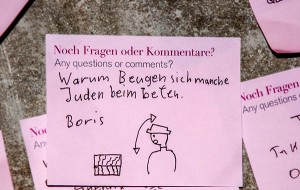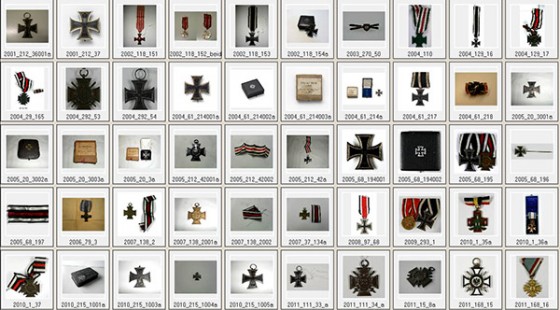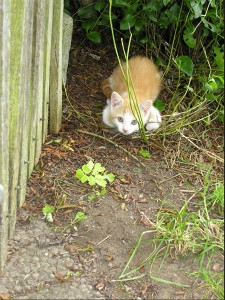“Why do some Jews rock back and forth while they pray?”
Our special exhibition “The Whole Truth… everything you always wanted to know about Jews” is based on 30 questions posed to the Jewish Museum Berlin or its staff over the past few years. In the exhibition, visitors have their own opportunity to ask questions or to leave comments on post-it notes. Some of these questions will be answered here in our blog, such as last month’s query: “how does a kippah stay on?” This month, we respond to Boris, who wants to know “why some Jews rock back and forth while they pray?”

“Why do some Jews rock back and forth while they pray? Boris”
© photo: Thomas Valentin Harb, Jewish Museum Berlin
Dear Boris,
Many people have asked why religious Jews sway back and forth while praying. This very old custom is called shuckling in Yiddish and means to rock, shake, or swing. As with many customs, it is easier to describe when and where it was practiced, than to answer definitively, why people shuckle while praying and studying the Torah. → continue reading
Everyday Absurdities at the Museum
Sometimes even a museum’s normal workday provides surprises. About a week ago I found in my postbox a letter from the provincial capital of Stuttgart, specifically, from its office for public order.
Information about fines and tickets occasionally lands on my desk, since I am in charge of a team that travels around Germany in our museum bus doing mobile educational work at schools. In the struggle against ignorance and anti-Semitism, speed is of the essence. So I flipped through to the second page to ascertain how much we owed this time: € 104,80. For animal custody and veterinary services?! This is no normal parking ticket.
I turned back to the first page and read the letter from top to bottom: “Saving Ms. K’s cat.” Did my colleagues run over a cat, or did they find one and take it to the animal shelter? → continue reading
The Jewish Museum is located in the well-known Berlin neighborhood of Kreuzberg, which is also home to a 66-meter high hill that gave the district its name in 1920: Kreuz meaning ‘cross’ and Berg ‘mount’ or ‘hill’. A monument designed by Friedrich Schinkel had been erected there about 100 years prior in memory of the war of liberation from Napoleon. On top it has always been bedecked with an Iron Cross. Prussian King Friedrich Wilhelm III first endowed the building of the monument 200 years ago, on 10 March 1813, the birthday of his late Queen Luise. A drawing of Schinkel’s design for the Iron Cross has been passed down to the Kupferstichkabinett’s collection (Museum of Prints and Drawings). In 1870 and 1914 respectively, Emperors Wilhelm I and II made subsequent endowments of the Iron Cross for particular service by German soldiers.
Numerous Iron Crosses can be found in the Jewish Museum’s collection, in many cases together with the respective certificates.

Iron Crosses in Kreuzberg – view of the object data bank of the Jewish Museum
© Jewish Museum Berlin
They nearly all date from the time of the First World War, in which around 100,000 Jewish soldiers participated on the German side. Among them were Julius Fliess (1876-1955) and Max Haller (1892-1960), whose medals are now in the Jewish Museum’s possession. → continue reading



